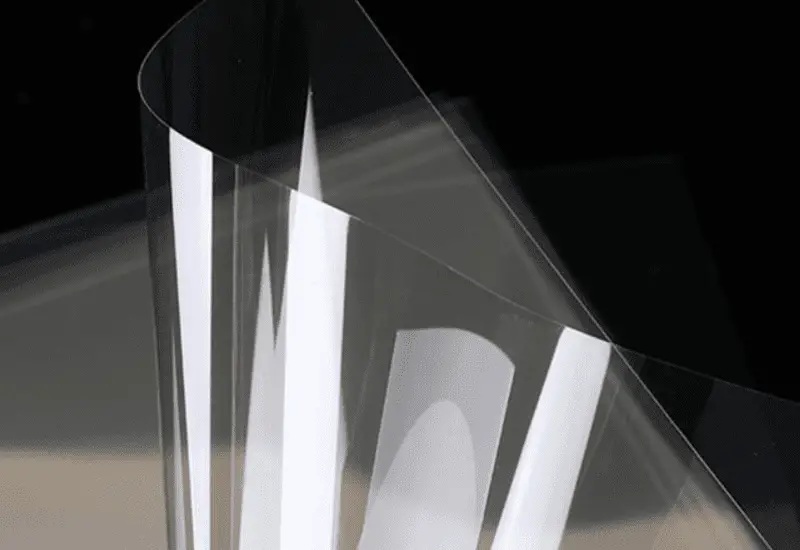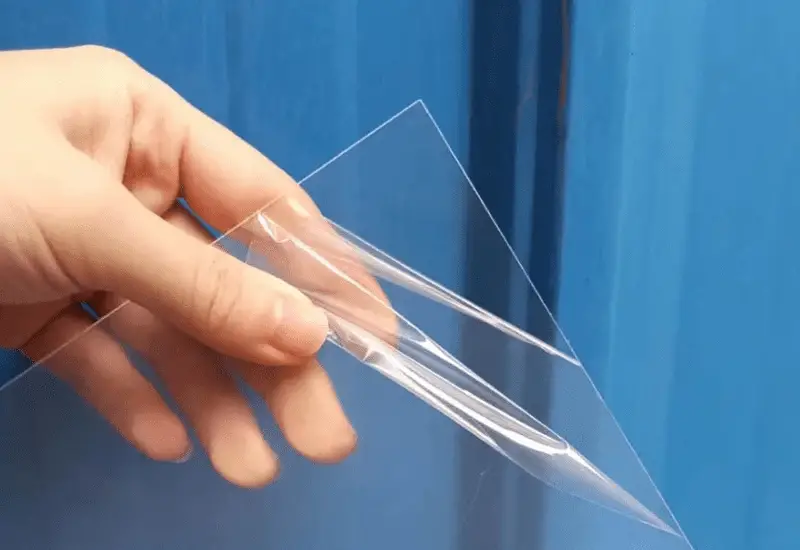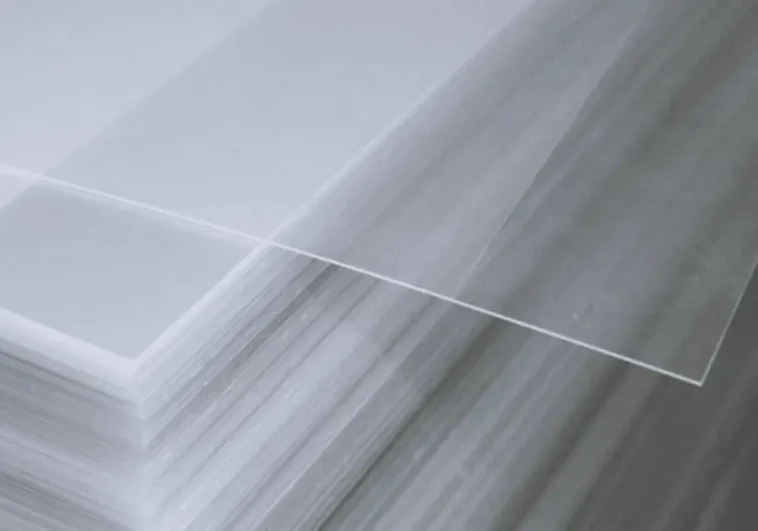If you’re looking for a strong, durable plastic that’s also easy to shape and recycle, then there’s no better choice than polyethylene terephthalate or PET. This is a material with which all of us are familiar. It’s the main ingredient in disposable plastic bottles, food packaging and trays, clothing and fabrics and more. And it’s by far the most recycled plastic, owing to its low cost and easy workability in various products.
Thicker PET, or sheet, for instance, is an affordable alternative to glass and glazing applications such as advertising and commercial signage, electronics and automotive components, street furniture, construction barriers, etc. It’s the combination of favourable properties, high availability and the ability to modify raw polyethylene terephthalate with a range of additives to produce specialist, engineered sheets with desirable finishes that make it so sought after.
What Is PET?

PET is a thermoplastic polymer belonging to the polyester family of plastics. It is lightweight, strong, flexible and colourless and is used in hundreds of applications. The material was first created in the 1940s and constitutes roughly half of all recycled plastics today. When used in fabrics and clothing, it goes by the name of polyester, while commercial and industrial applications go with the PET or PET resin moniker.
Thicker and rigid varieties, such as polyethylene terephthalate sheets, show excellent mechanical, chemical and heat resistance, paired with high dimensional stability. Easy formability and low production times and costs also prove handy.
How It’s Made
PET plastic sheet is made in several stages, including dehumidifying and drying raw polyethylene terephthalate chips, fibres or pellets, heating and extruding, then cooling and forming. The process changes the polyester from a viscous fluid to a transparent and semi-rigid solid, or an amorphous state resembling glass, and is known as A-PET.
Favourable Properties
The sheet has many favourable properties, especially when compared to other consumer-grade and commercial plastics. These include:
- High transparency and gloss – polyethylene terephthalate sheets have very high transparency and an appealing gloss appearance, making it ideal for glazing applications as a substitute for glass, and in numerous packaging items, including clear bottles, food containers and blister packaging.
- Excellent mechanical properties – the material is strong (up to 200 times more than standard float glass) and won’t break or fracture. It’s also rigid, has very good wear resistance, and can be formed into varying shapes and sizes. High strength and resistance to scratches, dents and damage make it good for signs and displays.
- Low weight – PET sheet is very lightweight, meaning it’s easy to transport and handle. It is substantially lighter than glass (up to 40 times) and comparable to other common plastic sheets, like acrylic and PVC.
- High heat and chemical resistance – PET sheets are good in applications that call for resistance to temperature extremes (with optimal performance between -60 to 130 degrees Celsius) and will stand up to common chemicals like alcohols, hydrocarbons, oil, grease and alkalis like caustic soda, potash and ammonia. Sheets also have very low water absorption, making them good for outdoor usage. With additives, PET is also UV resistant. This makes it suitable for many commercial and industrial uses, such as food and chemical packaging.
- Easy processing and formability – the wide range of applications is down to easy and quick processing methods. Sheets are extruded and can be had in varying thicknesses and densities while moulding, thermoforming and vacuum forming are used to get detailed and intricate shapes. The material can additionally be had with additives to further improve properties, such as anti-static qualities in electronics, or ant-slip surfaces in signs, displays and barriers.
- Recyclability – as mentioned, this is the most recycled plastic. Used PET products can be repurposed, such as in the production of new polyethylene terephthalate sheets. If you want sustainability and low production costs in terms of energy needs and waste levels, this is the plastic to choose from.
Additives and Commercial-Grade PET

Several additives are used with non-crystallised PET to further improve its properties or change appearance. This includes a range of antioxidants, flame-retardants, impact modifiers, pigments and colourants, and UV stabilisers.
For instance, antioxidants improve high-temperature stability, pigments and dyes change the inherently transparent appearance to something of your choice (opaque, frosted, coloured), UV stabilisers prevent yellowing and fading, and impact modifiers raise rigidity and improve overall strength. Commercial-grade PET can also include fillers, lubricants, nucleating agents and plasticizers.
Where Is PET Used?
Food packaging, trays, containers and bottles are the main industries that utilises PET. The material is food-safe, has high temperature ranges (ideal for freezing or microwaving), is transparent, and has good impact resistance. Food and liquids can be safely sealed, and there is no risk of external factors that can cause spoiling.
Specialised uses are more recent. Polyester clothing was introduced in the late 1960s, with recycled PET clothing now a trend with sustainability at its core. Signage and displays are another area where PET plastic sheets have seen substantial use, owing to low cost, minimal wear and weathering, and the ability to mimic a range of materials.
This has also been recognised in areas like the aerospace and automotive industries, where extruded PET sheets with their high heat, chemical and impact characteristics and low weight, are a good replacement for steel componentry. Engine covers, door trim, interior panels, headlamp retainers and a variety of exterior body parts are all made using PET sheets. Other industrial uses are machine parts, piston fillers, bearings, wheels and rollers.
PET Sheet Physical Characteristics
Depending on needs, PET sheets can be manufactured in varying sizes and thicknesses. Boards used for displays, signs and construction purposes are available in standard building sizes (2400 by 1200mm) or shorter and longer variants (such as 3350 by 2050mm or 2030 by 1014mm). Thickness ranges from extra-thin 0.2mm sheets to construction-grade sheets of up to 12mm seen in things like parking lot covers, pergolas and carports. The appeal of PET is down to its easy forming and shaping to meet individual needs and its versatility in varied applications.
Compared to Other Plastics
High-density polyethylene (HDPE) is another common plastic found in bottles and packaging. It has higher heat resistance and better sealing, so is better for chemicals and hazardous goods, while PET is more suitable for perishable goods. On the plus side, PET is transparent, has better impact resistance, is easier to recycle, and is cheaper to make and buy.
Simpler recyclability and repurposing are other advantages when compared to polyvinyl chloride (PVC). Non-toxicity and the fact that PET is odourless are what make it ideal in packaging. Still, PVC sheets tend to do better at edge sealing (specifically for construction and signage) and moisture resistance. If you’re willing to spend (considerably) more and are looking for better performance at higher temperatures and a plastic sheet that can be used in thermoforming and 3D printing, then a better option is the derivative PET-G with added glycol.




